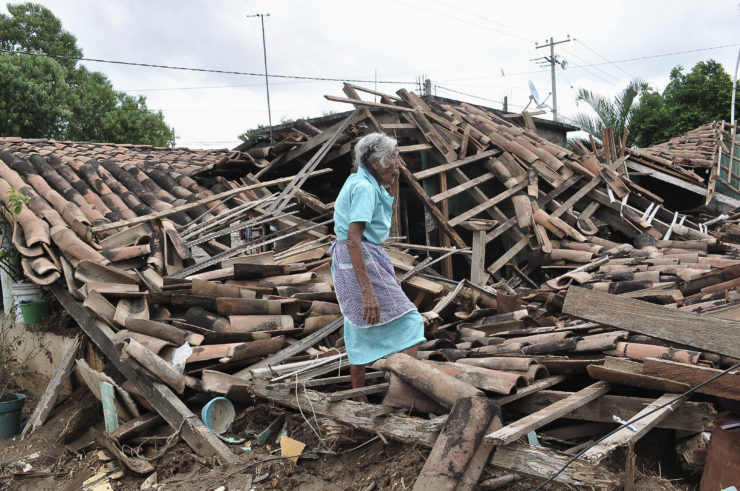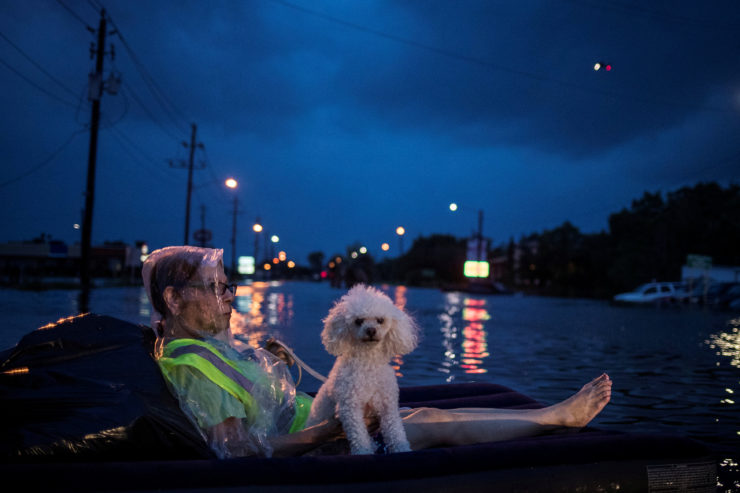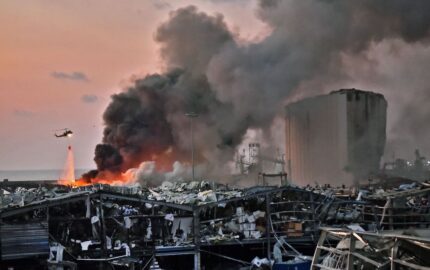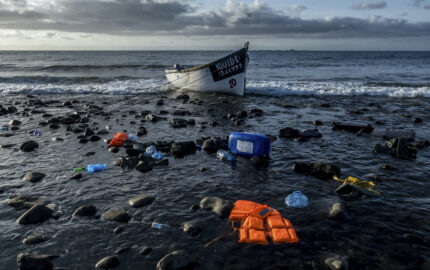The assignment was simple: find out what energy companies knew about climate change, and when they knew it. InsideClimate News (ICN) reporter Neela Banerjee was initially skeptical they’d find any significant evidence that fossil fuel companies knew about the dangers of global warming. “At first, we thought, this was ridiculous,” she says. “We are not going to find anything.” As the nonprofit news organization’s team began to work through congressional testimony and talk to climate scientists, however, they found mention that oil giant Exxon has not only been involved with climate change research, but had actually published studies in peer-reviewed journals in the 1980s.
One Exxon scientist, Henry Shaw, had even published studies as far back as the late 1970s. When Banerjee and her colleagues tracked down his research, they discovered Exxon had fitted out one of its supertankers with sophisticated equipment to monitor carbon dioxide in the ocean and the atmosphere at a time when few scientists were studying global warming at all. Though Shaw had passed away, the reporters discovered document after document showing how Exxon’s scientists had agreed that emissions from fossil fuel companies were warming the planet, putting humans at risk. “It was astounding,” Banerjee says.
InsideClimate News published its findings in a nine-part series, “Exxon: The Road Not Taken,” in fall 2015, detailing the extent of Exxon’s scientific research, as well as how the company covered it up after it turned in the 1980s to suddenly denying climate change existed. The story earned ICN a nomination for a Pulitzer in Public Service and it was a winner or a finalist for practically every other environmental and investigative award last year.
Despite the urgency of climate change as an issue, in-depth stories like the one produced by ICN are a rarity. A veteran of The New York Times and the Los Angeles Times, Banerjee joined ICN out of frustration at not being able to pursue in-depth investigations on the topic. “Top management in the newsroom don’t give a hoot about climate change: ‘It’s depressing. It’s boring. It’s not sexy,’” she says. “They’ll tell you it’s the most important beat on the planet, but unless it’s wrapped up in politics and who’s up who’s down, they don’t care.”
Coverage of climate change is still just a small fraction of the overall news budget
Statistics bear her out, in part. Aside from PBS, network broadcast news has virtually stopped covering the topic. A study published by Media Matters for America in March found evening newscasts and Sunday shows on ABC, CBS, NBC, and Fox devoted only 50 minutes combined on climate change last year—despite such important climate-related stories as the signing of the Paris climate agreement, several extreme weather events, and the presidential campaign—during which there were no debate questions about climate change.
“Coverage is nowhere near where it should be for something that is so central to understanding how we can live, work, play, relax in a 21st-century society,” says Maxwell Boykoff, author of the 2011 book “Who Speaks for the Climate?” and a University of Colorado professor who has been tracking news coverage of climate change for 15 years. “Television has very much shirked its responsibility, and that is very worrisome.”
Major newspapers, while better, have been uneven over the past decade. According to research by Boykoff and others, coverage in the five largest U.S. newspapers decreased from an average of nearly 400 stories a month by 2007 to less than half that five years later. While coverage has rebounded to about 300 a month over the past two years, coverage of climate change is still just a small fraction of the overall news budget, says Boykoff, mostly spiking around political events such as President Trump’s recent decision to pull out of the Paris accord, rather than in-depth coverage of how countries around the world are adapting to changes in climate, or how it is affecting the world’s poorest citizens.
“The coverage since Trump has taken office is as high as it’s been, but it’s stunning how much of it is pegged to his activities, worries, and threats,” says Boykoff. “It hasn’t enhanced productive discussion on these issues. Instead, it’s been filled with fear and woe and worry.” Case in point: a 7,000-word cover story in New York magazine in July called “The Uninhabitable Earth,” which envisioned an apocalyptic worst-case scenario of what climate change could wreak in the next century, complete with mass extinctions, famine, disease, and war. The story was criticized as too alarmist even by climate scientists and those who work in climate politics, including one who fretfully called it “climate disaster porn.”
It’s no wonder then that Americans are woefully undereducated on the topic. A 2016 study by the Yale Project on Climate Communication and George Mason University Center for Climate Change Communication, found only two-thirds of Americans even believe climate change is happening. Just over half believe it is caused by humans. And only 15 percent are aware that more than 9 out of 10 scientists agree on both points.
The dearth of coverage can be explained, at least in part, by the difficulty in covering an issue that defies most journalistic conventions, says Bud Ward, who has reported on the issue for more than 20 years and is editor of Yale Climate Connections, published by the Yale Project. Climate change is often perceived as an abstract concept, he says, lacking a timely news hook: “It affects only polar bears I’ll never see, or it will only take place in 2150 or beyond.” Just as crucially, since nearly all scientists are in agreement on the problem, the issue often lacks clearly defined sides. “The villain is us, or villains are everywhere.”

The science behind the phenomenon, meanwhile, often lacks headline-grabbing revelations. “Science’s goal is to incrementally advance fundamental understanding on very basic questions,” says John Wihbey, an assistant professor of journalism and new media at Northeastern University who recently collaborated with Ward on a paper about climate change coverage for Oxford Research Encyclopedia. “If they [scientists] can collect data, test a hypothesis, and show something new … they’ve done their job.” By contrast, he says, journalists’ goal is to inform as many people as possible in as accessible a way as possible. “They are both dedicated to truth, but the importance of publicity and the scope of the audience is just very different.”
That discrepancy creates an inherent difficulty for science writers in making the topic feel fresh and newsworthy. “You can write that sea ice is at an all-time low, but a month later, it will still be at an all-time low,” says Seth Borenstein, a veteran beat reporter on climate change for the Associated Press. “The same goes for the monthly global temperature. At some point, you are reporting the same thing again and again.” Borenstein frequently looks for fresh angles in the data, going back to past studies to see if current reality matches predictions, or searching for significant anniversaries—such as the moment when more people alive have never felt a cooler than average month—to create news hooks.
When considering climate issues, Borenstein says, newer journalists will make the mistake of pitting scientists against political experts or think tanks. “That is like the doctor telling you you have cancer, so you go to the dentist for a second opinion,” Borenstein says.
The problem of false balance is one that has dogged climate change since global warming first started becoming an issue in the late 1980s and early 1990s. In part due to lack of data—and in part due to intentional obfuscation by fossil-fuel companies and right-wing think tanks—reporters have struggled to give fair representation to all perspectives. Says Wihbey, “How do we cover this as a political issue that seems to have two sides, but where there seems to be overwhelming scientific data accumulating on one side?” Oftentimes, they settled for a “he said, she said” story, giving equal weight to both.
That started to change in the mid-2000s, especially after an influential paper Boykoff co-authored with his brother, Jules, a political scientist, entitled “Balance as Bias,” published in the journal Global Environmental Change in 2004. The Boykoffs analyzed more than 600 stories selected at random from The New York Times, The Washington Post, Los Angeles Times, and The Wall Street Journal. Despite the International Panel on Climate Change’s release of a scientific consensus that humans contributed to global warming, they found that more than half of the articles gave equal weight to human-caused and natural-caused explanations for the issue. “In other words,” the Boykoffs wrote, “through adherence to the norm of balance, the U.S. press systematically proliferated an informational bias.”
The dearth of coverage can be explained, at least in part, by the difficulty in covering an issue that defies most journalistic conventions
When the study was repeated a few years later, the problem of false balance had largely gone away—both as the evidence supporting man-made climate change grew stronger and as journalists grew savvier in their reporting.
That has made it all the more surprising that the issue of false balance has once again reared its head in the last six months, as the presence of climate change deniers in high positions in the current presidential administration has once again put journalists in a quandary. Recent statements by Environmental Protection Agency administrator Scott Pruitt, Energy Secretary Rick Perry, and President Trump himself questioning the science have been echoed by far-right media sites such as Breitbart, Infowars, and Daily Wire, and put new pressure on journalists to include dissenting views.
That has made it more crucial than ever that journalists are able to separate fact from opinion, says Emmanuel Vincent, a project scientist at the University of California, Merced, who launched the website Climate Feedback three years ago as a forum for scientists to weigh in on the accuracy of media coverage. “Rick Perry said that climate change is due to the oceans, and a journalist may just let it go and say that’s his opinion, but it contradicts reality,” he says. “It should be the job of the journalist to say that.”
One commonly held misconception about climate change science is that it can only predict trends in weather patterns and can’t be tied to specific events. That’s no longer true, says Heidi Cullen, chief scientist at Climate Central, a nonprofit partnership of scientists and journalists and a Columbia Ph.D. who was formerly The Weather Channel’s first on-air climate expert. “The science has evolved and the models have gotten better,” Cullen says, “so we now have these peer-reviewed methodologies that can attribute individual extreme weather events to climate change.”
That development can help journalists in search of news hooks that bring the effects of climate change home to their readers. In 2012, Climate Central launched a program to train local meteorologists in how to accurately report on climate change and created Surging Seas Risk Finder, an interactive website at which users can enter their zip code to see the projected effects of rising sea levels in their area.
A more extensive recent multimedia project by The Texas Tribune and ProPublica brought the effects of climate change down to an even more local level. Published last December, “Boomtown, Flood Town” details the devastating impact that stronger and more frequent rainstorms are having on the city of Houston, months before the devastation wrought by Hurricane Harvey in August. The story used weather data and statistical analysis to show that in the past 28 years, the Houston area has been hit by eight storms. Five of those storms are thought to have a one in 100 chance to occur in a year, including spring storms in the past two years that together led to the deaths of 16 people and required thousands of high-water rescues.
“Work by scientists has shown that the frequency of these storms is clearly going to be worse because sea levels are rising,” says Texas Tribune and Reveal reporter Neena Satija, who wrote the story with fellow Tribune reporter Kiah Collier and ProPublica’s Al Shaw. As readers scroll through, a data visualization dynamically zooms in on a map of Houston, which gradually lights up with colored dots showing where flooding occurred in those two storms—more than a third of which are outside the city’s official flood zone, expected to be flooded only once every 100 years.
As the story continues, it weaves in personal stories of residents affected by the floods, showing readers where their homes are located on the map—such as the home of a woman whose two granddaughters were trapped atop tables as dark floodwaters swirled around them during the infamous “Tax Day” flood of 2016. At the same time, it demonstrates how policy decisions can exacerbate the effects of climate change. Runaway development in Harris County where Houston is located has replaced acres of prairie grass, formerly protected by switchgrass, which can have roots as deep as 15 feet, with impervious paved surfaces that impede drainage. By showing those areas of development on the map along with the areas affected by flooding, the visualization helps make apparent the political decisions behind the problem.
Despite those clear associations, the public officials the team interviewed are largely in denial about the effects. The former head of the flood-control district, according to the story, “flat-out disagrees with scientific evidence that shows development is making flooding worse,” and Houston still has no plans to take climate change into account. Since the story was published, residents of Memorial City, a neighborhood particularly hard hit by the flooding, have used it in their lobbying efforts to improve the city’s flood control infrastructure.
As Hurricane Harvey was bearing down on the Gulf Coast in late August, the reporters wrote a follow-up story, warning that the city wasn't ready for the potential catastrophic consequences of the third superstorm in as many years. Unfortunately, meteorologists' worst nightmares came true, as almost two feet of rain fell on the city overnight, stranding dozens of residents and causing at least five storm-related deaths in one of the worst natural disasters in Texas history.


Tying climate change to other issues, such as urban development, is one way to make the issue more accessible to a broader range of readers.
Stories by Indian journalist Stella Paul show just how far-reaching the impacts of climate change can be. While researching AIDS in India in 2012, she noticed two cities that had a significant jump in the number of women working in the sex trade in the southern city of Hyderabad. Investigating that rise, she discovered that many of the women had recently come to the city from agricultural areas decimated by drought, often after their husbands had committed suicide. Paul interviewed more than 50 women for the story she wrote about the issue for Reuters, shedding light on an unknown consequence of climate change that was hidden in plain sight. “The death of farmers from suicide had been covered very widely, but there was a story right next to it that wasn’t covered at all,” she says.
After that experience, Paul began searching for other stories at the intersection of climate change, gender, and human rights. Through an online network of women activists posting from Africa, South America, and other regions, she began to uncover more issues that had remained under the radar. One recent story details an increase in women being sexually assaulted in Guatemala because they are forced to walk farther to fetch water. Efforts by international NGOs to provide clean water to the villages took on an added urgency from the attacks. “It wasn’t just a health issue, it was a security issue,” she says.
By exploring such topics, Paul says, she is able to create new interest in both climate change and human rights issues. Finding stories like these sometimes just takes a shift of focus in applying a climate change lens to whatever beat a reporter is currently on. As one example, she remembers a journalist at a workshop in Bhutan, who was struggling to find a business journalism angle on the country. “But Bhutan is completely reliant on tourism, and if the glaciers melt, they won’t have enough hydroelectric power,” she says. “A lot times reporters aren’t even aware of the stories they have when they are sitting right on them.”
One organization that has recently put more effort into funding climate change stories is the Pulitzer Center on Crisis Reporting, which has sponsored more than 50 projects looking in-depth at the effect of climate change on lives and livelihoods around the world. One project over the past year for publications including National Geographic looked at the way Bangladesh is adapting to rising sea levels—including “floating hospitals” in low-lying areas where permanent hospitals are no longer possible. In another story it funded this spring for The New York Times, reporter Kai Schultz looks at the island nation of the Maldives, where a green tax on resorts has fallen prey to government corruption, leaving guesthouse owners—and tourists—unprotected from rising seas. Despite the $3-a-night tax paid by tourists at guesthouses, residents on one island have been forced to construct their own makeshift seawall out of pieces of concrete and broken tiles to protect themselves from the surging waves.
In addition to funding articles, the Pulitzer Center’s efforts have focused on outreach to bring climate change stories to more diverse constituencies. To date, it has formed partnerships with 35 colleges and universities, ranging from liberal arts schools to large state colleges, as well as high schools and middle schools in St. Louis, Chicago, New York, Washington, D.C., Philadelphia, and North Carolina to design curricula around climate change topics. “They are more or less neutral spaces where you can engage people who have maybe not made up their minds,” says Jon Sawyer, executive director of the Pulitzer Center.
For future grants, the center is working in a component that gives additional funding for efforts to reach new audiences with innovative techniques, such as data visualization or short videos for social media. “There is a lot of disinformation and distortion out there, with large segments of society being inundated with sources telling them climate change is not an issue,” Sawyer says. “Show us how a piece might end up on Fox or right-wing radio and have some credibility.”

Sawyer is not the only journalist working to find unconventional ways to tell climate change stories in order to reach a broader audience. After writing about climate change for 15 years, radio journalist Jason Margolis was feeling frustrated that he was only reaching those who were already convinced by the science. “I wanted to try and hit that sweet spot where people could still be persuaded to listen,” he says. Through a yearlong Knight-Wallace Fellowship at the University of Michigan, he developed new angles on the story, taking as his inspiration comedians like Jon Stewart and John Oliver, who are able to tell hard-hitting new stories in an entertaining way.
The stories he has produced in the past few years for Public Radio International address the topic of climate change with a breezy, even quirky sensibility. One features a climate activist and self-dubbed “eco-tainer” in Indianapolis, who emcees a monthly game show called “Ain’t Too Late Show” that has the audience in stitches at the same time it teaches them climate facts. Another follows the story of a composer who created a classical music concept album that follows a drop of water from snow pack to ocean to atmosphere as a way to draw attention to climate-induced water shortages. He’s clearly struck a nerve: The album, which includes lyrics from ancient texts in 10 different languages, debuted at number 1 on Billboard’s traditional classical album chart.
Several of Margolis’s recent stories are set in Mexico, where Margolis took an extended trip. Among his stops was the legendary, if faded, resort town of Acapulco, which was ravaged by tropical storm Manuel the previous fall. Many of the interviews he’d arranged with resort owners were lackluster—for them, the storm was a dramatic event from which they quickly recovered.
Walking down the beach with his fixer, however, he discovered a village where residents were still recovering from the damage. “When you go to one of these resort towns, you forget about the people who are washing your dishes and changing your sheets,” he says. “After the storm, this hotel was up and running five minutes later, and these people’s lives were destroyed. It’s a good reminder that if you have money, then even with the worst of climate change, you can pay your way out of it.” Despite the heaviness of the topic, Margolis still keeps the tone conversational as he talks to a community leader who has vowed to stick it out in his hometown, which dates back 400 years, despite the fact that many of its houses are now buried with silt that overflowed from the nearby river.
The problem of false balance is one that has dogged climate change since global warming first started becoming an issue
A similar balance between serious subject matter and engaging delivery has been the hallmark of “Years of Living Dangerously,” the television series on the National Geographic Channel (previously on Showtime). The show follows an unusual hybrid model, bringing in actors and other celebrities to investigate serious climate-related issues. In the inaugural episode, Harrison Ford travels to Indonesia to investigate deforestation from palm oil plantations. In later episodes, “Dawson’s Creek” alum Joshua Jackson explores coral bleaching, Jessica Alba talks with clean energy entrepreneurs, and—in one of his few appearances post-“Late Show”—David Letterman charmingly examines India’s transition to a solar-based economy.
“There is always a risk bringing in Hollywood actors that you will turn some people off,” says co-creator Joel Bach. But that’s outweighed, he says, by the huge amounts of additional attention they can draw. Still, Bach and co-creator David Gelber—both former producers of “60 Minutes”—are careful not to position the stars as experts on the subject matter. “They are really proxies for the viewer, and there to learn along with the audience,” Gelber says.
Bach and Gelber created the series after struggling to cover climate change at “60 Minutes.” “I had this sense that my God this really is the biggest story out there, and ‘60 Minutes’ wasn’t covering it the way we wanted to,” Gelber says. In addition to the star power, the producers focused on high production values, shooting episodes in a highly cinematic fashion. Despite the shiny surface, the show doesn’t sacrifice journalistic rigor, tackling complex scientific and economic concepts in naturalistic on-location interviews and trying to focus on solutions, rather than just fill the screen with doom and gloom. They hope their show can be an antidote to the almost total lack of coverage of the issue on network news. “I mean, God damn it,” Gelber says. “Twenty years from now, people will look back at NBC, CBS, and ABC and wonder what the bleep were they thinking.”
Whether the nightly news is covering it or the current presidential administration is supporting it, there are still plenty of stories out there on climate change for enterprising journalists to discover, says Yale’s Ward. In addition to exploring how individual communities are affected by and adapting to climate change, there are legitimate policy debates about the best solutions—whether to support technologies, such as natural gas and nuclear, and how to best support and incentivize a switch to renewable energy that can drive down the amount of greenhouse gases in the atmosphere.
While climate change is perhaps the global issue, it is an intensely local one, with effects from climate change felt on agriculture and business from coastal cities to rural farms. The place to look for stories is close to home as well, says Northeastern’s Wihbey. “The more you bring scientists and journalists together it’s all to the good,” he says. “In any given city or region, there are going to be just a handful of climate scientists and just a handful of journalists who cover the environment. I would think any small organization can provide some event space and a lunch and just say, ‘Hey, we want to bring you guys together to talk on an informal basis.’”




